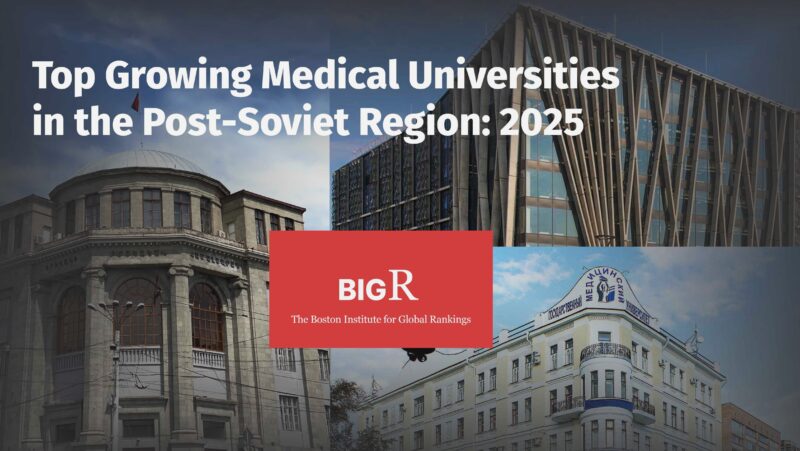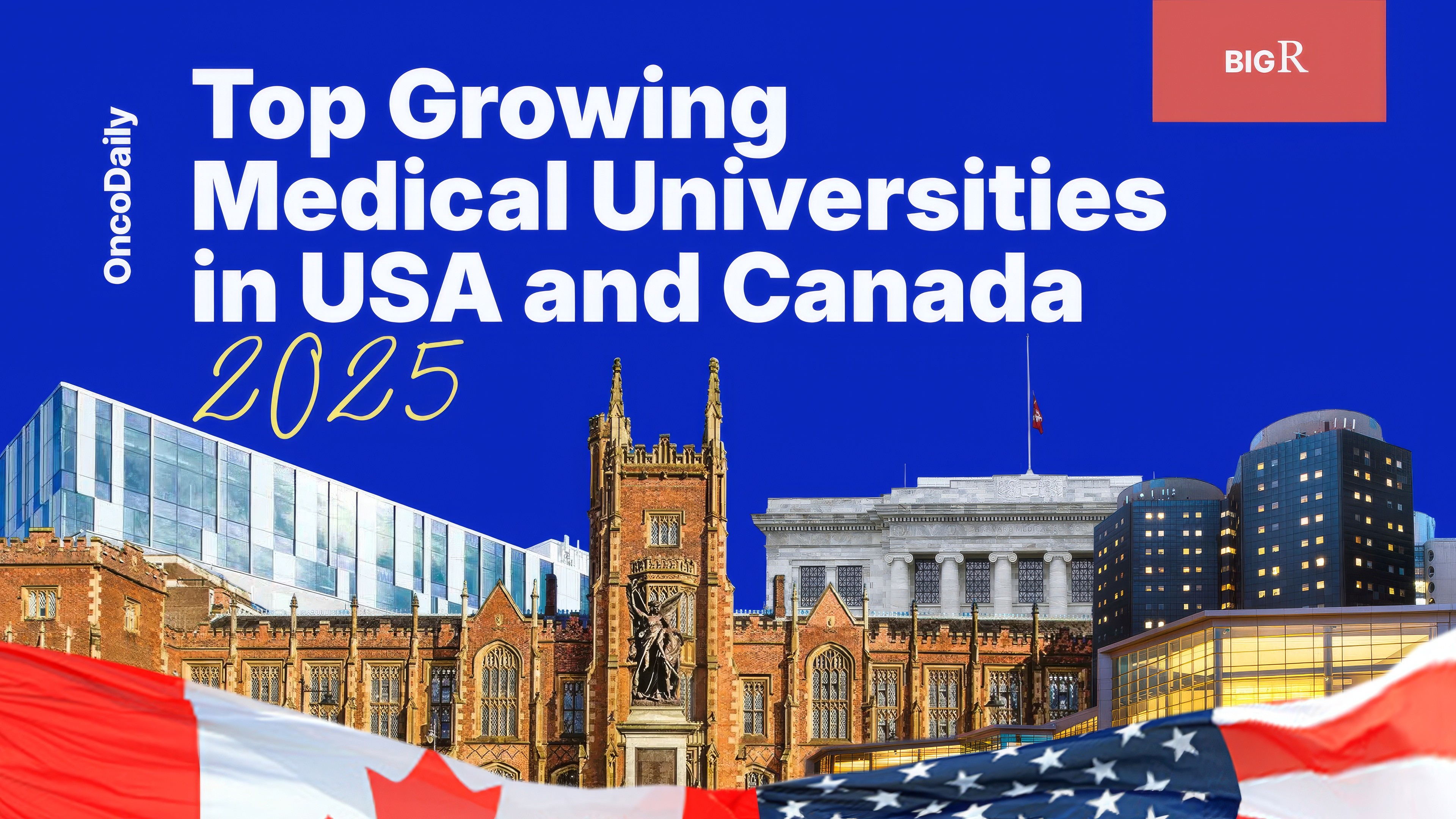In the 21st century medical research has undergone a remarkable transformation. The research enterprise has expanded from siloed labs and local trials to large, multi-center collaborations integrating oncology, immunology, AI, and public health. The United States and Canada, home to some of the most influential medical institutions on Earth, have not only driven these changes but continuously re-invented the model of academic medicine itself.
Yet a fascinating question remains challenging the accepted reality:
Which of these universities are accelerating the fastest – not merely producing large volumes of research, but expanding their scientific momentum relative to their own histories?
To capture and measure this evolution, the Boston Institute for Global Rankings (BIGR) launched an ambitious analysis of medical research output indexed in the National Library of Medicine’s PubMed database from 2000 to 2024, applying the Exponentially Weighted Growth Index (EWGI) – a transparent, dynamic measure of growth that rewards sustained acceleration rather than size alone.
This USA and Canada 2025 edition builds on BIGR’s inaugural Post-Soviet ranking and introduces a complementary lens: not only who leads in growing output, but who has mastered the art of momentum. Alongside the EWGI results, the study also unveils the “All-Time Giants” – institutions whose cumulative PubMed footprints define the very landscape of modern medicine.

Scope of the Study: From Hundreds to a Focused Cohort
- Geography: United States and Canada
- Period analyzed: 2000–2024 (inclusive)
- Data source: National Library of Medicine (PubMed)
- Inclusion threshold: ≥ 500 PubMed-indexed publications across the period
- Final sample: 160 medical institutions meeting the criterion
Our analysis began with the World Directory of Medical Schools, comprising 249 medical institutions across USA and Canada. However, to ensure that our ranking was both meaningful and credible, we established a key inclusion criterion: only universities with at least 500 publications indexed in PubMed during the 2000-2024 period were considered. By filtering out smaller or inactive institutions, we focused on those demonstrating sustained, measurable research life.
Why Measure Growth in Research Output?
Scientific publications are a fundamental measure of a university’s contribution to global knowledge and innovation.
But publication counts alone reveal who is large – not who is evolving.
Growth rate captures adaptability, responsiveness, and investment in people, ideas, and technology. For young schools, rapid publication acceleration signals successful entry into the global research ecosystem; for established giants, steady growth proves that legacy does not mean stagnation.
Methodology: Measuring Momentum with the Exponentially Weighted Growth Index (EWGI)
To fairly evaluate growth, we needed a method that would:
- Reward recent achievements without ignoring historical contributions.
- Avoid arbitrary cutoffs like “last 5 years” or “last 10 years.”
We developed and utilized the Exponentially Weighted Growth Index (EWGI). Here’s how it works:
Step 1: Assigning Exponential Weights
Each year from 2000 to 2024 was assigned a weight that naturally emphasized more recent years. Using a decay parameter of seven years (τ = 7), the method ensures that an article published in 2023 has a greater influence than one from 2003, while still allowing every publication to contribute to the overall trend.
Step 2: Calculating Weighted Average Growth (WAG)
We multiplied each year’s publication count by its respective weight and divided the total by the sum of all weights. This step provided a measure of recent productivity that gradually prioritizes newer work without ignoring earlier contributions.
Step 3: Calculating Historical Average (HA)
We then computed the simple, unweighted average number of publications across all years of active output. Only years with at least one publication were counted, ensuring that newer institutions were not penalized for inactive periods before their research activity began. Years without any publications were excluded from the denominator to ensure a fair reflection of active scientific productivity, avoiding distortion caused by inactive periods.
Step 4: Computing the EWGI
Finally, the weighted recent performance was compared to the historical average and expressed as a percentage. An EWGI above 100 % indicates growth beyond the institution’s historical norm – a sign of acceleration.
This method allows us to highlight institutions demonstrating real, sustained scientific growth – not just temporary publication spikes – and provides a fair basis for comparison across universities of different sizes and ages.
Strategic Insights: Four Pillars of Momentum
Real-world behaviors that tend to drive research growth.
- Infrastructure Investment – The rise of translational centers, imaging cores, and bioinformatics hubs has allowed smaller or newer institutions to rival the giants.
- Collaborative Networks – Growth leaders are active participants in national and international consortia – particularly NIH cooperative trials, AI health collaborations, and precision-oncology programs.
- Faculty Development – Programs that fund sabbaticals, international research exchanges, and internal grants correlate with sharper EWGI increases.
- Publication Incentives and Research Culture – Transparent systems that recognize PubMed-indexed output, grant conversion rates, and mentorship contributions sustain long-term productivity.
The 2025 List: Meet the Top Growing Medical Universities in USA and Canada
- Renaissance School of Medicine at Stony Brook University, USA – 244.0%
- Nova Southeastern University Dr. Kiran C. Patel College of Osteopathic Medicine Fort Lauderdale, USA – 242.0%
- Columbia University Vagelos College of Physicians and Surgeons, USA – 229.3%
- Lake Erie College of Osteopathic Medicine – Erie, USA – 218.5%
- Queen’s University Faculty of Health Sciences, Canada – 216.8%
- Western University of Health Sciences College of Osteopathic Medicine of the Pacific, USA – 212.5%
- Duke University School of Medicine, USA – 211.0%
- University of British Columbia Faculty of Medicine, Canada – 208.7%
- University of Ottawa Faculty of Medicine, Canada – 206.7%
- University of Arizona College of Medicine Phoenix, USA – 206.4%
- Oregon Health and Science University School of Medicine, USA – 205.0%
- CUNY School of Medicine, USA – 203.9%
- Jacobs School of Medicine and Biomedical Sciences, University at Buffalo, USA – 203.6%
- Oklahoma State University Center for Health Sciences College of Osteopathic Medicine, USA – 203.4%
- George Washington University School of Medicine, USA – 202.3%
- Meharry Medical College School of Medicine, USA – 201.4%
- Cumming School of Medicine, University of Calgary, Canada – 200.8%
- Rowan-Virtua School of Osteopathic Medicine, USA – 200.5%
- McGovern Medical School at The University of Texas Health Science Center at Houston, USA – 200.0%
- New York Institute of Technology College of Osteopathic Medicine, USA – 199.7%
- Philadelphia College of Osteopathic Medicine, USA – 198.1%
- UC San Diego School of Medicine, USA – 198.0%
- University of Alberta Faculty of Medicine and Dentistry, Canada – 196.4%
- Midwestern University Arizona College of Osteopathic Medicine, USA – 196.3%
- Dalhousie University Faculty of Medicine, Canada – 196.3%
- Université de Montréal Faculté de Médecine, Canada – 195.8%
- Stanford School of Medicine, USA – 194.6%
- University of Arkansas for Medical Sciences College of Medicine, USA – 193.1%
- Michigan State University College of Human Medicine, USA – 193.0%
- The Ohio State University College of Medicine, USA – 192.9%
- University of Toronto Temerty Faculty of Medicine, Canada – 191.2%
- University of Missouri Kansas City School of Medicine, USA – 190.2%
- University of Colorado School of Medicine, USA – 187.3%
- Michael G. DeGroote School of Medicine, McMaster University, Canada – 186.0%
- Creighton University School of Medicine, USA – 185.4%
- Université Laval Faculté de Médecine, Canada – 183.7%
- Florida State University College of Medicine, USA – 183.5%
- University of California, San Francisco, School of Medicine, USA – 183.0%
- Midwestern University Chicago College of Osteopathic Medicine, USA – 183.0%
- Georgetown University School of Medicine, USA – 182.2%
- Northwestern University Feinberg School of Medicine, USA – 182.2%
- Sanford School of Medicine of the University of South Dakota, USA – 181.0%
- Virginia Commonwealth University School of Medicine, USA – 180.0%
- Mayo Clinic Alix School of Medicine, USA – 179.5%
- University of Cincinnati College of Medicine, USA – 177.6%
- Rutgers Robert Wood Johnson Medical School, USA – 177.6%
- Case Western Reserve University School of Medicine, USA – 176.8%
- F. Edward Hébert School of Medicine, Uniformed Services University of the Health Sciences, USA – 176.6%
- Tulane University School of Medicine, USA – 176.2%
- Perelman School of Medicine at University of Pennsylvania, USA – 175.3%
- UC Davis School of Medicine, USA – 174.9%
- University of Chicago Pritzker School of Medicine, USA – 174.4%
- Schulich School of Medicine and Dentistry, Western University, Canada – 173.6%
- University of Wisconsin School of Medicine and Public Health, USA – 172.4%
- Icahn School of Medicine at Mount Sinai, USA – 172.2%
- Joan C. Edwards School of Medicine at Marshall University, USA – 171.3%
- Université de Sherbrooke Faculté de Médecine et des Sciences de la Santé, Canada – 171.3%
- University of Arizona College of Medicine Tucson, USA – 171.3%
- University of California, Irvine, School of Medicine, USA – 171.2%
- University of Connecticut School of Medicine, USA – 170.0%
- University of Virginia School of Medicine, USA – 169.9%
- University of Missouri School of Medicine, USA – 169.6%
- University of Kansas School of Medicine, USA – 169.4%
- Keck School of Medicine of the University of Southern California, USA – 168.9%
- Howard University College of Medicine, USA – 168.2%
- University of North Carolina School of Medicine, USA – 166.9%
- Max Rady College of Medicine, University of Manitoba, Canada – 166.8%
- Northeast Ohio Medical University (NEOMED), USA – 166.5%
- Warren Alpert Medical School of Brown University, USA – 166.0%
- Spencer Fox Eccles School of Medicine at the University of Utah, USA – 165.3%
- Sidney Kimmel Medical College at Thomas Jefferson University, USA – 164.5%
- University of Washington School of Medicine, USA – 163.9%
- University of Florida College of Medicine, USA – 163.3%
- University of Minnesota Medical School, USA – 163.2%
- Harvard Medical School, USA – 162.4%
- West Virginia University School of Medicine, USA – 161.7%
- Yale School of Medicine, USA – 161.5%
- Johns Hopkins University School of Medicine, USA – 160.4%
- Emory University School of Medicine, USA – 159.9%
- Weill Cornell Medical College, USA – 159.6%
- Morehouse School of Medicine, USA – 159.5%
- Stritch School of Medicine, Loyola University of Chicago, USA – 159.5%
- Boston University Chobanian & Avedisian School of Medicine, USA – 159.3%
- Medical College of Wisconsin, USA – 159.0%
- University of Maryland School of Medicine, USA – 158.9%
- University of Illinois College of Medicine, USA – 158.8%
- Baylor College of Medicine, USA – 157.3%
- Indiana University School of Medicine, USA – 156.7%
- John A. Burns School of Medicine, University of Hawaii at Manoa, USA – 155.9%
- Mercer University School of Medicine, USA – 155.7%
- Northern Ontario School of Medicine University, Canada – 155.1%
- Memorial University of Newfoundland Faculty of Medicine, Canada – 154.7%
- University of Miami Miller School of Medicine, USA – 154.5%
- University of Michigan Medical School, USA – 153.9%
- Loma Linda University School of Medicine, USA – 153.9%
- Lewis Katz School of Medicine at Temple University, USA – 153.4%
- Geisel School of Medicine at Dartmouth, USA – 153.2%
- University of Puerto Rico School of Medicine, USA – 153.0%
- University of New Mexico School of Medicine, USA – 152.2%
- Louisiana State University School of Medicine in New Orleans, USA – 151.9%
Renaissance School of Medicine at Stony Brook University, USA – 244.0%

Founded in 1971 on Long Island as a public medical school, the Renaissance School of Medicine at Stony Brook University has undergone a $423 million expansion (completed in 2019) and rebranded after more than $500 million in philanthropic gifts from families associated with Renaissance Technologies. Those donations seeded 34 endowed faculty chairs, nine research centers and a hospital expansion – fueling its transformation from regional actor into a national research contender and helping it leap ahead in momentum.
Nova Southeastern University Dr. Kiran C. Patel College of Osteopathic Medicine Fort Lauderdale, USA – 242.0%

Located in Fort Lauderdale, this college stands out not just for its rapid rise but for being part of a university that offers both an allopathic and an osteopathic medical path. As Florida’s largest private R1 research university, Nova Southeastern has become a pride model for osteopathic schools by scaling its research output and accelerating in the rankings faster than many older, more traditional institutions.
Columbia University Vagelos College of Physicians and Surgeons, USA – 229.3%

Founded in 1767, Columbia’s medical school is one of America’s oldest. But its recent trajectory is anything but historic-only: under the Vagelos name it has embraced precision genomics, AI integration in health-care delivery and global health equity programs, merging legacy prestige with next-gen scientific ambition proving that scientific growth has no limits. The result: a momentum profile that outpaces many younger peers.
Queen’s University Faculty of Health Sciences, Canada – 216.8%

At Kingston, Ontario, Queen’s Health Sciences traces its roots to 1854 and has recently become a vanguard of Canada’s research resurgence. Its focus on cancer genomics, Indigenous-led health initiatives and digital-health innovation marks Queen’s as a symbol of Canada’s rising scientific ambition and cross-border competitiveness. Many of the mind-bending research studies in oncology have come from this Canadian powerhouse which leads the team-Canada including University of British Columbia Faculty of Medicine, Canada (208.7%), University of Ottawa Faculty of Medicine, Canada (206.7%) and others.
Remarkably, ten of Canada’s fifteen medical universities landed in the top 50 – a clear signal that Canada is not just participating in the global race for discovery but setting its own pace.
Notably, fifty to sixty percent of the top fifty fastest-growing medical universities are public institutions – proof that sustained public investment, faculty empowerment, and cross-border collaboration can rival the research engines traditionally fueled by private endowments.
The All-Time Giants: Top 20 by Total Publications (2000–2024)
While EWGI highlights momentum, the giants of North American medicine remain unmatched in absolute numbers.
- Harvard Medical School – 274,516 publications
- Baylor College of Medicine – 79,302 publications
- Yale School of Medicine – 79,046 publications
- Perelman School of Medicine, University of Pennsylvania – 73,898 publications
- Johns Hopkins University School of Medicine – 72,512 publications
- Stanford University School of Medicine (USA) – 68,937 publications
- Mayo Clinic Alix School of Medicine (USA) – 65,288 publications
- Washington University School of Medicine in St. Louis (USA) – 64,411 publications
- University of Toronto Temerty Faculty of Medicine (Canada) – 63,007 publications
- University of California, San Francisco School of Medicine (USA) – 61,623 publications
- Columbia University Vagelos College of Physicians and Surgeons (USA) – 59,740 publications
- University of Michigan Medical School (USA) – 57,289 publications
- Duke University School of Medicine (USA) – 55,903 publications
- University of Washington School of Medicine (USA) – 53,726 publications
- University of Pittsburgh School of Medicine (USA) – 53,492 publications
- University of British Columbia Faculty of Medicine (Canada) – 49,801 publications
- Northwestern University Feinberg School of Medicine (USA) – 48,563 publications
- University of California, Los Angeles David Geffen School of Medicine (USA) – 48,241 publications
- University of California, San Diego School of Medicine (USA) – 46,785 publications
- University of Pennsylvania (USA) – 45,967 publications
Harvard Medical School – 274,516 publications
HMS faculty and trainees have been credited with 15 Nobel Prizes in Physiology or Medicine — more than any other medical school in the world.

Harvard’s scientific empire spans three centuries of innovation – from the world’s first cancer research labs to the modern genome era. Its affiliates drive one in every 20 PubMed papers worldwide. Harvard’s growth today lies not in numbers alone but in its ability to continuously reinvent how medicine is done – through AI integration, open data partnerships, and translational hubs that bridge the bench and the bedside.
Baylor College of Medicine – 79,302 publications
Baylor College of Medicine drove the sequencing of chromosomes 3, 12 and part of X as one of just three centers contributing directly to the draft of the Human Genome Project.

Born in Houston’s Medical Center, Baylor embodies the American South’s biomedical renaissance. From the first heart transplants to modern gene-editing trials, its ethos blends clinical courage with academic grit. Baylor’s recent explosion in genomics and vaccine research reaffirms its status as a powerhouse of applied innovation.
Yale School of Medicine – 79,046 publications
Yale became the first U.S. medical school to require a research thesis for every medical student, a practice it began back in 1839 — over 180 years ago.

Founded in 1810, Yale transformed from an East Coast institution into a global symbol of scholar-physician culture. From the first X-ray experiments in New Haven to cutting-edge AI-based diagnostics, its campus is where tradition meets reinvention. Yale’s interdisciplinary DNA has kept its research curve resilient and renewing through the centuries.
Discussion: Patterns, Contrasts, and Fascinating Facts
Rankings often celebrate what has been achieved; EWGI reveals what is becoming possible.
For policy makers, it offers a data-driven lens on investment efficiency. For universities, it illuminates where innovation cultures are flourishing – and where they need renewal. And for young researchers, it shows that exponential growth is not the privilege of the historic few, but the reward of strategic vision.
The findings also suggest that North American medical education is in a new renaissance. The emphasis is shifting from infrastructure alone to intellectual velocity – how fast a university can transform knowledge into impact. In a world where disease outpaces bureaucracy, that speed is not a metric – it’s a mandate.
Reading the Momentum: The Shift, the Surge, and the Subtle Slowdown
Over 270,000 publications in 25 years – that’s Harvard’s unmatched output, the very definition of scale. The legends of North American medicine – Harvard, Johns Hopkins, Stanford, Yale, and Penn – have found their rhythm. Their curves no longer rise sharply but flow steadily upward, embodying the stability of institutions that long ago secured their place in scientific history. Stability here doesn’t mean stagnation – it means mastery.
Yet, on the other end of the graph, a new kind of energy pulses. Kirk Kerkorian School of Medicine at UNLV, Nova Southeastern University Dr. Kiran C. Patel College of Osteopathic Medicine, and even the historically powerhouse Mayo Clinic Alix School of Medicine are rising fast, their growth trajectories sharp and determined. If they sustain their current momentum, they may well stand shoulder-to-shoulder with the All-Time Giants within the next decade.
Interestingly, data show that even among the top 20 universities by EWGI, the last five years have brought signs of moderate deceleration. The hope – and the likelihood – is that this temporary moderation will give way to another surge as emerging technologies, AI integration, and cross-border collaborations reshape research ecosystems across the continent.
This trend also guided our methodological evolution for this region: while the EWGI remains the gold standard of growth, we are now exploring composite criteria that account for stability, innovation, and resilience – recognizing that new universities often experience meteoric early rises followed by natural plateaus, and sadly, even declines.
If you’re a student, researcher, or policymaker planning your next move, we hope this analysis offers clarity beyond the classic names.
Everyone loves Cher and ABBA, but sometimes the next generation’s rhythm – Lorde and Twenty One Pilots – is where the future beat begins.
The Promise of Momentum
What makes this analysis exciting is its narrative power. Behind each curve lies a story of visionary deans, grants won and lost, faculty returning home after global fellowships, and labs that refused to close during crises. The EWGI translates those stories into numbers – and numbers back into stories.
If the past 25 years were defined by scale, the next 25 will be defined by momentum. Universities that adapt quickly, collaborate globally, and invest in data-driven innovation will dominate the medical science maps of 2040.
The trajectory is clear: the future of medicine belongs not only to those who lead today, but to those who are accelerating toward tomorrow.
by Elen Baloyan, MD, Director of BIGR and Managing Editor at OncoDaily, and Hana Maheen, Research Data Associate at BIGR and Editor at OncoDaily
About BIGR
This study was conducted by The Boston Institute for Global Rankings (BIGR) – an academic initiative dedicated to transparent, data-driven evaluation of excellence in universities, medical centers, and healthcare professionals worldwide. With focus on performance, impact, and innovation, BIGR aims to create meaningful global benchmarks for the future.
Think BIGR.
Follow our upcoming rankings on the OncoDaily website.
